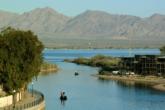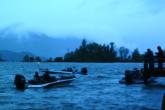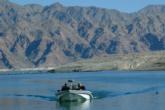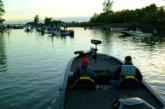2005 EverStart Series preview: Western Division
Wild West to offer a little bit of everything for anglers, fans

The EverStart Series Western Division will visit four familiar fisheries in its third season. After a one-year absence, Lake Mead returns as one of four tour stops in 2005. Rounding out the list of top-notch angling venues are three of last year’s most popular destinations: Lake Havasu, Clear Lake and the California Delta. In true Western Division fashion, the slate of beautifully scenic waterways should produce some of the biggest bass caught all year on any trail.
Here is just a sampling of what West Coast anglers and fans alike can expect from this year’s schedule:
Lake Havasu
Lake Havasu City, Ariz.
Jan. 26-29
 Unlike the two California destinations, it’ll be survival of the fittest on Lake Havasu in January, when bites are stingy and the weather is unpredictable. Since the event will be held two months earlier than last year, anglers can throw nearly everything they learned about Havasu in March out the window.
Unlike the two California destinations, it’ll be survival of the fittest on Lake Havasu in January, when bites are stingy and the weather is unpredictable. Since the event will be held two months earlier than last year, anglers can throw nearly everything they learned about Havasu in March out the window.
The population of bass in Havasu continues to grow thanks to an ongoing multimillion-dollar habitat-improvement initiative that has created abundant reproductive habitat for bass. As such, the fishing on Havasu is far better than it was not too long ago. However, due to cool water temperatures in January, the fishing is probably not going to be easy.
“It’s pretty tough,” said Lake Havasu City resident Mike Goodwin, who won last season’s EverStart event on Havasu. “The smallmouths are going to be in prespawn mode, and the largemouths are still going to be hanging back a little ways.”
As of late December, Goodwin said water temperatures were in the 50s and the bass had not yet begun to move toward the banks. “They should be starting to move a little bit – especially the smallmouths – around the end of the month of January,” he said. “If we get some warm days and a couple of weeks of good, warm weather, our smallmouth fishing could get really good.
“We can get some cold Januarys,” Goodwin continued. “And if we get a north wind and a cold front comes through, it can shut the fishing completely down.”
Goodwin recommends the Bill Williams River on the south end of the lake as a potential productive fishing site during the tournament, and he predicts that many competitors will be able to find fish in the river tules – defined as any of several bulrushes growing in marshy lowlands of the southwest United States.
“(Havasu) is pretty much a shallow lake,” he said. “There is some offshore structure. There will be a bite in the manmade structure – brush piles, habitat trees and plastic trees.”
He looks for the reaction-bait bite to be strong and says deep-diving crankbaits will also be a good choice. Jerkbaits are also likely to catch Havasu bass in late January.
“January is typically a tough month on this lake, but as soon as that water temperature starts to go the other way, the bite gets really good here,” Goodwin said. “The fishing’s not going to be anything like it was in the EverStart tournament in 2004 – those fish were all over the banks and running everywhere. It’s not going to be that easy.
“I think it’s going to take 24 to 25 pounds to win for the final two days and 17 to 18 pounds to make the top-10 cut,” he said. “It could take less than that, but if we get a couple of good weeks of warm, stable weather, it’ll take that.”
Clear Lake
Lakeport, Calif.
March 9-12
 Sometimes referred to as the “Bass Capital of the West,” Clear Lake is the largest natural freshwater lake in California. Its 68 square miles of surface area hides its rocky bottom, and its 100-plus miles of shoreline offers excellent fishing for largemouth bass. It is even believed that the site of Clear Lake has held water for more than 2.5 million years.
Sometimes referred to as the “Bass Capital of the West,” Clear Lake is the largest natural freshwater lake in California. Its 68 square miles of surface area hides its rocky bottom, and its 100-plus miles of shoreline offers excellent fishing for largemouth bass. It is even believed that the site of Clear Lake has held water for more than 2.5 million years.
Stockton, Calif., pro David Gliebe knows a thing or two about Clear Lake, having posted two Wal-Mart Bass Fishing League wins there in 2000 and 2001 and finishing fifth there at the EverStart Series event in 2004. He’s predicting a solid prespawn bite that could result in several 25-pound-plus sacks of bass.
“Early March will definitely be a prespawn bite,” Gliebe said. “You’ll find them on isolated pilings close to shore as well as on the docks. There will also be fish swimming in and out of the tules. A 25-pound stringer is not all that hard to come by as long as you know what you’re doing.”
Gliebe looks for the flipping bite to be excellent in Rodman Slough at the north end of the lake and in Cache Slough on the south end. He likes either flipping or fishing shallow structure in 5 to 15 feet of water, and he looks for brown and green or black and red jigs to be productive baits.
Clear Lake’s healthy population of bass is what gives it its good name, according to Gliebe. “The lake’s in great shape; it’s been that way for almost 10 years,” he said. “It’s had a couple of lulls, but I don’t know what it is about that lake – it’s come back. It’s got tons of bass in it and the fish are very healthy too.”
Clear Lake weather in March can be unpredictable, but anglers had better hope that it’s not windy, as the lake can produce large waves that can make boat navigation troubling at best.
“It could be quite wet or it could be beautiful; you never know,” Gliebe said. “The clearer weather is best. If the wind blows from the north, it could be quite dangerous. The waves could get huge.”
Overall, Gliebe thinks March and April are the best times of the year to fish Clear Lake as far as overall ability to catch large fish. He also predicts it could take as much as 50 pounds over two days to claim the win. He says Clear Lake bass grow to such magnificent proportions because of abundant amounts of forage and steady diet.
“The lake’s full of shad,” he said. “There’s an unbelievable amount of crawdad – there’s a gigantic red and black crawdad on every other tule. They have a healthy diet.”
Lake Mead
Henderson, Nev.
April 6-9
 For anglers who don’t like to be crowded, Lake Mead is the place to go for solitary fishing. The huge, deep lake – it covers 550 miles of shoreline when full – was created by the construction of the Hoover Dam in the 1930s and is located within the Mojave Desert. It borders Nevada and Arizona and is part of the extensive Lake Mead Recreational Area that is twice as large as the state of Rhode Island.
For anglers who don’t like to be crowded, Lake Mead is the place to go for solitary fishing. The huge, deep lake – it covers 550 miles of shoreline when full – was created by the construction of the Hoover Dam in the 1930s and is located within the Mojave Desert. It borders Nevada and Arizona and is part of the extensive Lake Mead Recreational Area that is twice as large as the state of Rhode Island.
The EverStart Series has only visited Lake Mead once, and that event was won by Sean Minderman of Spokane, Wash. Minderman predicts that early April on Mead will be a sight-fisherman’s paradise, with lots of spawning fish on their beds.
“(Mead) doesn’t have a huge population of bass, but that time of year, the majority of the bass will be visible,” Minderman said. “It’s very clear. There are certain areas, like the inlets, that will get some color, and those can be really good areas too. However, the visibility is still 4 feet or better.”
For sight-fishing, Minderman likes tubes in natural colors such as green pumpkin and watermelon. If the weather is windy, he recommends spinnerbaits, which will also work first thing in the morning.
Lake Mead is currently experiencing drought conditions that may or may not affect the fishing, depending on whom you ask.
“It has affected the fishing,” Minderman said. “I think the populations of fish are still there, but it just fishes differently with the water being so low. I think that time of year, you just want to cover a lot of water and find concentrations of fish. Get a good pair of polarized glasses; they’ll be anywhere from a foot of water to 15 feet deep. You should be able to see them.”
Minderman says fish will be spawning in rocky areas due to the absence of bushes thanks to the low-water conditions. He predicts great fishing weather, with highs in the 70s and 80s, and the optimal conditions could mean a winning weight of up to 30 pounds.
“I would consider (early April) an ideal time to fish the lake,” Minderman said. “I like Mead because it is a very large lake, so it spreads out the anglers. You can definitely find areas there where you have miles and miles of water to fish, and there’s not another boat in sight. If you like to get away from the crowds of fishermen, it’s nice.”
California Delta
Bethel Island, Calif.
May 4-7
 The fishing on the California Delta in early May should be interesting to say the least, with fish in every stage of the spawn and tidal water to boot. That said, the fishing should be phenomenal, according to Yuba City, Calif., pro Gary Dobyns.
The fishing on the California Delta in early May should be interesting to say the least, with fish in every stage of the spawn and tidal water to boot. That said, the fishing should be phenomenal, according to Yuba City, Calif., pro Gary Dobyns.
Fishing the Delta in May does not favor any one type of fishing, says Dobyns, and that’s what makes it an ideal time to fish there.
“Early May is a great time; it’s a full-blown spawn bite but it’s also a great time of year for a top-water,” he said. “Any way you want to fish, you can. Me personally, I’m going to be throwing a top-water for a bigger bite. It’s great for a Senko, it’s great for flipping … whatever your style is, you’ll be able to catch fish on it.”
While most of the fish will be spawning, there will be a lot of bass in prespawn mode and a lot in postspawn.
“These are the biggest weights you’ll see all year,” Dobyns said. “The fish are up out of the river channel and are more accessible. You can fish however you want. It’s the absolute best time of the year to fish.”
Dobyns expects the weather to be warm for the tournament, with highs in the low to mid-80s. As a tidal system, the water level generally stays consistent on the Delta. However, the tides can swing as much as 7 feet during the course of a tournament.
“It can be anywhere from a 2- to 3-foot swing, or it could be a 5-, 6- or 7-foot swing,” he said. “It makes a lot of difference; it positions the fish a lot differently. For the most part, we do a lot better with reaction baits in high water. Then on low water, the flippers take over.”
Dobyns said 99 percent of fish caught in the Delta are caught in water less than 10 feet deep. The Delta has several rivers running into it with a lot of flooded islands and shallow water. Deep water exists, but fish tend to be found shallow.
“The fishery is a 10 on a scale of 1 to 10,” Dobyns said. “It’s doing very, very well. I think it’ll take 20 pounds a day for the most part, but there’s going to be a lot bigger limits than 20 pounds weighed in. I guarantee you I’ll get some bites. I’ve just got to put them in the boat.”